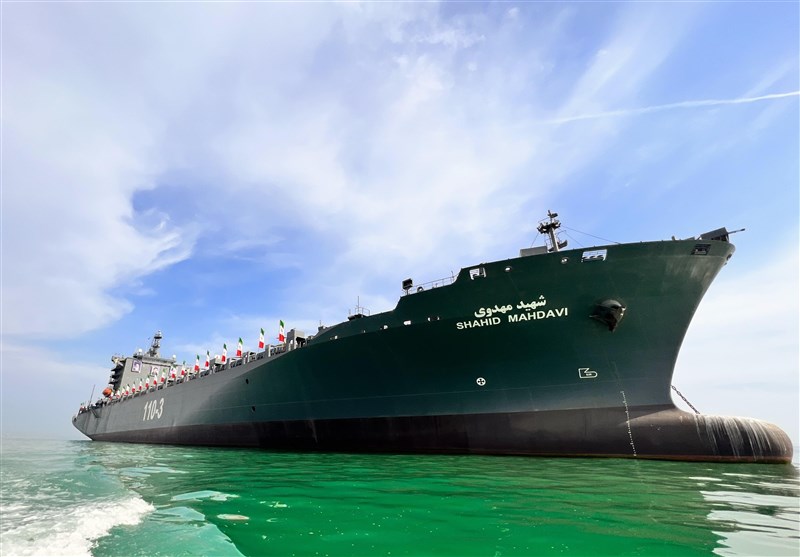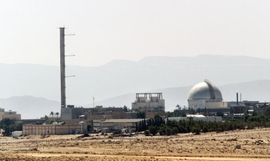The Islamic Revolution Guards Corps (IRGC) recently added a new ocean-going warship and 99 missile-launching boats to its fleet.
The vessels joined the fleet during a ceremony joined by IRGC Navy Commander Rear Adm Alireza Tangsiri and IRGC Commander Major General Hossein Salami in the southern port of Bandar Abbas, Tasnim News Agency reported on March 9.
The Shahid Mahdavi was described as a forward base ship, and is reportedly a retrofit of an Iranian cargo ship known as the Sarvin.
The 2,100-ton warship has a length of 240 meters and a width of 27 meters, Rear Admiral Tangsiri said, adding that it is equipped with a 3-dimensional phased-array radar as well as surface-to-surface and surface-to-air missiles, highly advanced electronic warfare telecommunication systems, and Khordad-3 missile systems, and cruise missiles with a range of 700 km. It is capable of carrying helicopters, fast patrol boats and drones.
“Shahid Mahdavi ocean-going vessel is ready to carry out missions with all the necessary equipment and facilities to create stable security in the seas,” he said.
The IRGC’s Navy also received new domestically designed vessels that have missile launchers mounted on them. The vessels that joined the Navy fleet were upgraded versions of the Ashura and Tareq classes.
The vessels can launch rockets with a range of between 100 and 180 kilometers. They can also enjoy high manoeuvrability and are capable of carrying out missions in different weather conditions.
The fleet upgrade comes amidst growing tensions between Iran and its arch-enemy Israel. Iran claims to have deployed more weapons and radars following threats from Israel, which says that military force was not ruled out while Iran continues to expand its nuclear program.
Earlier, the Chief of Staff of the Armed Forces, Major General Mohammad Hossein Baqeri, said Iran is "mass-producing" technology that would allow ballistic missiles to strike moving naval vessels.
Iran is one of three countries to possess this capability, Baqeri said on March 6.
He said that with a speed in excess of Mach 8 and a range of 1,500 km, the missiles would "create substantial security in the surrounding oceans up to a range of more than a thousand kilometres".
Aircraft carriers and other vessels within that radius "would not have security," the general added.
Earlier, the Chief of the IRGC Aerospace Force, Brigadier General Ali Hajizadeh, made an announcement about the Paveh cruise missile with a range of 1,650 km.
The senior commander stated in late February that the country had reduced the weight of its long-range missiles to one-fourth and was preparing to lower it to a sixth.
Elsewhere in his remarks, Hajizadeh advised Europe not to test the Islamic Republic, saying the country had intentionally capped the range of its missiles "out of respect" for the continent.
He further reminded that his force is "capable of targeting American aircraft carriers at a 2,000-kilometer (1,242-miles) distance".
On March 6, Iran’s Defence Minister Brigadier General Mohammad Reza Ashtiani said Iran does not need to purchase Russian S-400 air defence systems.
Iran has attained "self-sufficiency" in air defence, the minister said, and boasted about the Iranian-made Bavar-373 missile defence system having "many" potential buyers.
His remarks came after The Jerusalem Post’s report that Iran sought to buy S-400 systems from Russia, which is an upgrade to the S-300 air defence system. Bavar-373, which Tehran unveiled in 2019, is modelled after the Russian-made S-300.







 The Mine Action Agency of Azerbaijan (ANAMA) reported on Thursday the discovery of a significant amount of explosives in the Khojavand district of ...
The Mine Action Agency of Azerbaijan (ANAMA) reported on Thursday the discovery of a significant amount of explosives in the Khojavand district of ...
 Russian peacekeeping forces, deployed in the Karabakh (Garabagh) region of Azerbaijan since 2020, have commenced their withdrawal from the area.
Russian peacekeeping forces, deployed in the Karabakh (Garabagh) region of Azerbaijan since 2020, have commenced their withdrawal from the area.
 Azerbaijan officially unveiled the logo for the upcoming 29th session of the Conference of the Parties to the United Nations Framework Convention o...
Azerbaijan officially unveiled the logo for the upcoming 29th session of the Conference of the Parties to the United Nations Framework Convention o...
 The Kazakh authorities have increased their arbitration claims against international oil companies involved in the development of the Kashagan oil ...
The Kazakh authorities have increased their arbitration claims against international oil companies involved in the development of the Kashagan oil ...
 Russian Foreign Minister Sergei Lavrov has reasserted that Moscow has no intentions to stop the fighting in Ukraine, even if peace talks commence.
Russian Foreign Minister Sergei Lavrov has reasserted that Moscow has no intentions to stop the fighting in Ukraine, even if peace talks commence.



